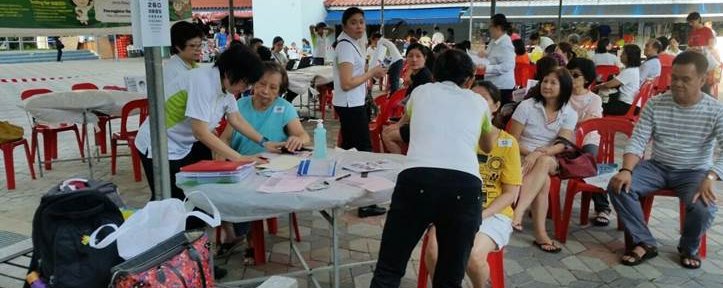CHESS was launched in February 2017 to address the problems of eye care inaccessibility to the elderly residents, delayed diagnoses and management of eye diseases. Novel teaching methods were implemented to rapidly heighten community nurses’ eye screening skills. Ground breaking innovations were introduced to evolve CHESS further. It is a cost-effective eye care model that has detected a significant number of asymptomatic eye conditions and has reduced the need for specialist referrals.
Innovation Summary
Innovation Overview
Project Background
Regular mass untargeted eye screenings do not reach the appropriate vulnerable populations in the community, especially the elderly, uneducated and frail. In order to address this gap, the Community & Home Eye Screening Service (CHESS) was launched in February 2017.
The team identified that mass community eye screenings were done infrequently since they are is labour-intensive. The projected manpower for a 300-patient community eye screening is about 30 staff (6 eye doctors, 6 optometrists, 6 nurses, and 12 patient service associates). It also involves the coordination of multiple resources such as manpower, eye equipment (reliance on vendors to support) and participants (dependence on the community partners to publicise and recruit).
Nevertheless, seniors in the community need to receive timely treatment to improve outcomes. As such, they need to have easy access to community eye care where the early detection of eye conditions can be achieved. To provide community eye screening services, several innovative projects were developed to upkeep CHESS.
Strategy for Change
CHESS was developed to provide First-level Community Eye Screening (FiLCES) and Second-level Eye Consultation Team (SeLECT) for early detection and management of treatable eye conditions that are accessible to Singapore residents who live in the north.
FiLCES involves the detection of functional decline in vision through various screening tests. These tests are performed by trained nurses and healthcare assistants from the Population Health & Community Transformation (PHCT) team. Seniors who fail the test are referred to SeLECT eye screening for further visual testing. SeLECT is performed by a trained optometrist. The optometrist also corresponds with an ophthalmologist through Tele-consult.
A pilot project was carried out from May – June 2016 to set the baseline data. It showed that 40.3% (52/129 patients) diagnosed to have one or more eye conditions at FiLCES.
A trans-disciplinary collaboration involving the various departments led to the innovation of a new care model with the following goals:
* To increase accessibility of community eye care using trained nurses & optometrists.
* To be cost effective by leveraging on existing resources and optimising usage of the resources.
* To train & accredit the nurses from Ageing-In-Place (AIP) & Population Health Program (PHP) to perform FiLCES with a novel teaching methodology:
- CHESS training curriculum comprised of lectures & hands-on training. Module 1 covers Visual Acuity Testing (VAT) & Intra-Ocular Pressure Measurement (IOPM). Module 2 covers the Torchlight Eye Screening Test (TEST) which is taught using a self-developed, innovative e-learning platform –TEACHES-LEM (Training enhancement and accreditation for Community and Home Eye Screening – Learning Electronic Module).
- The newly developed accreditation exam, Eye Screening Skills for Eye Nursing Competency Examination (ESSENCE), which requires a passing score of at least 80% (32/40) required for accreditation.
-A low-cost clinical examination tool (a visual guide for TEST) was developed in-house to aid the nurses in their clinical practice during eye screening.
*To train & accredit the optometrists to perform SeLECT under an Ophthalmologist’s supervision via tele-medicine using TigerConnect.
Benefits
CHESS managed to detect the top 5 eye abnormalities such as poor vision, eyelid position abnormalities, conjunctiva abnormalities, Amsler chart abnormalities and lens abnormalities. CHESS achieved its objective of providing easy access to community eye care, and contributing to the management of uncomplicated eye conditions in the community. This reduced the need for hospital referrals.
Besides providing care in the community, CHESS also introduced an innovative smart phone application known as Macular Amsler Testing Application (MATA). It was developed to allow sustainable self-monitoring by at-risk seniors. This eye scanning interface detects if the correct eye is being covered as well as ensures that the working distance of the chart to the patient’s eye is correct. The App features several step-by-step menus with instructional videos to engage the patient and help them navigate through the Amsler test correctly. The App is available for download via both Play Store and App Store for patients to monitor themselves using their own phone/tablet.
Scaling up
The team realised that one of the common causes of vision loss, known as glaucoma, which is often asymptomatic in the early stages, can be better screened by improving CHESS. The CHESS team comprising of optometrists & ophthalmologists, PHCT nurses & operations staffs collaborated to develop Glaucoma Community-based Augmented Review and Empowerment (G-CARE).
Besides G-CARE, the team is currently in the early stage discussion on Retina CARE using Optical Coherence tomography (OCT) machine. The team would subsequently move up to Anterior Segment CARE.
Innovation Description
What Makes Your Project Innovative?
Our project innovations includes:
Level 1 - using nurses to do eye screening in residential areas frequented by seniors. This improves accessibility and receptiveness of the seniors going for screening. Most screening done in an ad-hoc basis in the healthcare institution.
Level 2 - Using optometrist to manage level 1 referrals through Tele-consultation (smartphone) with hospital ophthalmologist to reduce hospital referrals.
Using innovative, cost-effective teaching methods (Flipped classroom and mental rehearsal) to rapidly produce competent eye care providers.
Using cognitive task analysis to develop TEST (Torchlight Eye Screening Test) to enable detection of common eye conditions using low cost tools.
TEACHES-LEM is a novel e-learning platform to upgrade community opticians to do eye screening besides fitting glasses. The study contents are presented using the principals of cognitive load theory of multimedia learning to optimise skill acquisition within a short time frame.
What is the current status of your innovation?
On-going
FiLCES was designed to screen leading vision-threatening diseases by doing Visual Acuity testing, TEST & Amsler Grid Testing. As glaucoma is asymptomatic in earlier stages, there is a need to augment CHESS’s screening methods.
The diagnostic capability for CHESS was enhanced by introducing G-CARE into CHESS with the following strategies:
G – Glaucoma (a blinding eye condition associated with high pressure and optic nerve damage)
C – Community-based
A – Augmented with various innovative eye examination to improve diagnostic capability in detecting glaucoma
Upgraded TEST – Shadow’s Test
Eye pressure measurement with a portable tonometer
Glaucoma Screening Questionnaire – glaucoma risk calculator
Virtual Reality Goggles to perform portable visual field assessment at SeLECT
R – Review & manage stable eye conditions
E – Empower patients & the public alike through engagement, education & self-developed technology enablers e.g. Macular Amsler Testing Application (MATA)
Innovation Development
Collaborations & Partnerships
*Ageing-In-Place (AIP) – a community outreach program to provide patient home visits.
*Population Health Program (PHP) - conducts regular health screenings at the community.
*Optometrists from Yishun Health.
*Wellness Kampung and NTUC Health Active Aging Hub (AAH) - provides venue for elderly residents for social engagement activities, health literacy & intervention programs.
*NHG Polyclinic – establish a seamless referral flow between polyclinic and hospital for eye specialist management.
Users, Stakeholders & Beneficiaries
*Seniors – Improved management of uncomplicated eye conditions in the community obviating hospital referral. This may result in early detection of eye conditions especially glaucoma for timely treatment and improved outcome.
*Ophthalmologist extenders – Nurses, optometrists and opticians performing at the top of their licenses, raising job satisfaction & professional profile.
*Secondary school students were trained by TEACHES to perform visual acuity testing.
Innovation Reflections
Results, Outcomes & Impacts
CHESS with GCARE contributes to help keep the population healthy and focuses on senior wellness, self-care education, early detection & prevention of eye diseases.
Seniors screened since Feb 2017 - Feb 2020:
*FilCES: 15,088
*SeLECT: 1,116
-52.6% (7,150 ) seniors who were screened do not need specialist referral
-FiLCES analysis: Of the 15,088 FiLCES seniors, 47.4% (7,150) were detected having one/more eye conditions & 24.1% (3,639 / 15,088) were referred to SeLECT.
-SeLECT analysis: Of the 1,116 seniors seen under SeLECT, 40.6% could be managed in the community while 59.4% needed specialist referral.
Seniors receive eye care with seamless referral to specialists via CHESS and also get a more complete screening through G-CARE.
The projected cost savings range from $10-$39/ patient by avoiding polyclinic/specialist visits. Also, early intervention reduces direct medical cost. The hospital is also able to achieve manpower cost-savings of $75,000/year with ophthalmologist-extenders.
Challenges and Failures
The challenges and management are as follows:
* Nurses and optometrist were initially unreceptive to work on top of their license. There were concerns of medical licensing and medical legal consideration.
- Protocols and standard operating procedures for patient care were endorsed by the senior management.
- A good training, accreditation and re-accreditation programme were developed to maintain competency and high professional standard.
* Multiple stakeholders with different perspectives causing occasional disagreement.
- Clear communication of vision and mission to all stakeholders.
- Frequent stakeholder dialogue and engagement to co-develop the programme and problem-solve.
- Identifying a venue for SeLECT.
* Many bulky eye instruments are used in SeLECT. Hence, a large enough venue is needed.
- Yishun Health manage to sign a Memorandum Of Understanding with NTUC AAH to collaborate and provide the facility.
Conditions for Success
A helicopter view of a healthcare ecosystem is adopted. This requires the team to take small steps and calculated risks to do quality improvement projects (e.g. TEACHES-LEM, portable perimeter, MATA) in phases that build towards the final care model.
Strong support from senior management and hospital leadership is necessary to drive the new policies and patient care protocols.
A trans-disciplinary approach involving experts in different fields is used to co-develop this innovative programme. It is crucial to identify change agents from respective fields. Shared leadership amongst the change agents creates ownership and nudge them to work in a concerted effort to implement and sustain the change.
The project leader needs to use authentic leadership (AL) which comprises of positive psychology, optimism and resiliency, morality, self-awareness and self-regulation. He influences his followers to find meaning in working towards a common goal of improving patient care.
Replication
CHESS is an on-going initiative in Yishun Health that is ever evolving to cater to the greying population. MOH adopted the CHESS care model to initiate Project Silver Screen (PSS), a national community screening programme. PSS was launched nationwide in Sep 2018 to screen seniors aged 60 years old and above, for their visual, hearing and dental functions.
Besides, MOH leveraged on SeLECT concept to start the Clinical Optometry and Community Screening (COCS), which involves private optometrists to provide level 2 community eye care in collaboration with the public hospitals.
In KTPH, the SeLECT concept was further applied to develop the step-down primary eye care (SPEC) model. This model is for the management of stable chronic eye conditions such as diabetic retinopathy and dry eyes by accredited clinical optometrists. This manpower transformation resulted in significant health care cost reduction and manpower optimisation without compromising patient care quality and safety.
Lessons Learned
Community eye care involves a complex healthcare eco-system with different care components. The respective stakeholders and deficient areas of the constituent care components should be identified and addressed by the leader.
For the stakeholders, the leader should exhibit authentic leadership characteristics such as optimism, morality, resilience and self-regulation to influence them in adopting the changes that support the CHESS programme. The stakeholders should be engaged in the development of the programme’s vision and mission. A minimal specification approach is needed to empower them to own and initiate the change initiatives in this complex adaptive system.
For the deficient areas, a system-based thinking is needed to design a holistic community eye care model. The quality improvement initiatives that address the deficiencies should be planned and executed in concert, in order to provide a comprehensive eye care framework.
Anything Else?
CHESS is a trans-disciplinary, population-based project in Northern Singapore using accredited nurses and optometrist to do different levels of community eye screening on elderly and home-bound residents (15,088 screened, as of January 2020). It improves accessibility to eye care in the community and frees up hospital resources for more complex eye care. A training and accreditation system, based on sound pedagogical principles and learning theories, was established to prepare these professionals in work top of their licenses in providing primary eye care.
A collaboration with NHG Polyclinic was established to provide a seamless, hassle-free specialist referral system to reduce non-compliance and default. CHESS also pioneered using Tiger Text® Apps on smartphones for Ophthalmology Tele-consultation without using expensive IT platforms. CHESS is ever evolving to early detect more eye conditions with innovative concepts and cost-effective technology to improve patient outcomes.
Status:
- Diffusing Lessons - using what was learnt to inform other projects and understanding how the innovation can be applied in other ways
Files:
Date Published:
11 February 2021


